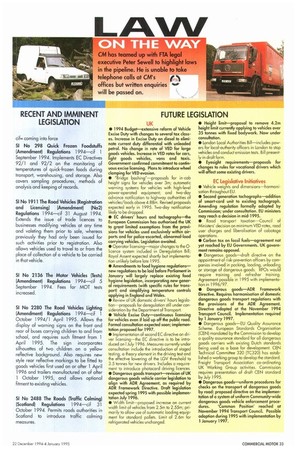FUTURE LEGISLATION
Page 35

If you've noticed an error in this article please click here to report it so we can fix it.
UK • 1994 Budget—extensive reform of Vehicle Excise Duty with changes to several tax classes. Increase in Excise Duty on diesel to eliminate current duty differential with unleaded petrol. No change in rote of VED for large goods vehicles. Increase in VED rates for cars, light goods vehicles, vans and taxis. Government confirmed commitment to continuous excise licensing. Plans to introduce wheel damping for VED evasion. • "Bridge bashing"—proposals for in-cab height signs for vehicles over 3m; automatic warning systems for vehicles with high-level power-operated equipment; and two-day advance notification to highway authorities of vehicles/loads above 4.88m. Revised proposals expected early in 1995. Two-day notification likely to be dropped.
• EC drivers' hours and tachographs—the European Commission has authorised the UK to grant limited exemptions from the provisions for vehicles used exclusively within airports and for police-escorted, abnormal-load carrying vehicles. Legislation awaited.
• Operator licensing—major changes to the 0licence system included in Deregulation Bill; Royal Assent expected shortly but implementation unlikely before late 1995.
• Amendments to food hygiene regulations— new regulations to be laid before Parliament in January will largely replace existing food hygiene legislation, incorporating new general requirements (with specific rules for transport) and simplifying temperature controls applying in England and Wales. • Review of UK domestic drivers hours legislation—proposals for deregulation still under consideration by the Department of Transport.
• Vehicle Excise Duty—continuous licensing for vehicles even if laid up off the public road. Formal consultation expected soon; implementation proposed for 1997.
• Implementation of second EC directive on driver licensing—the EC directive is to be introduced on 1July 1996. Measures currently under consultation include the introduction of staged testing, a theory element in the driving test and the effective lowering of the LGV threshold to 3.5 tonnes for new drivers. Includes a requirement to introduce photocard driving licences.
• Dangerous goods transport—revision of UK dangerous goods vehicle carrier legislation to align with ADR Agreement, as required by ADR Framework Directive. Draft legislation expected spring 1995 with possible implementation July 1996.
• Width limit—proposed increase on current width limit of vehicles from 2.5m to 2.55m; primarily to allow use of automatic loading equipment for standard pallets. Limit of 2.6m for refrigerated vehicles unchanged.
• Height limit—proposal to remove 4.2m height limit currently applying to vehicles over 35 tonnes with fixed bodywork. Now under consultation.
• London Local Authorities Bill—includes powers for local-authority officers in London to stop vehicles and conduct emission tests. Bill presently in draft form.
• Eyesight requirements—proposals for changes to rules for vocational drivers which will affect some existing drivers.
EC Legislative Initiatives
• Vehicle weights and dimensions—harmonisation throughout EU.
• Second generation tachographs—addition of smart-card unit to existing tachograph. Amending regulation formally adopted by Commission; under consultation. EU ministers may reach a decision in mid-1995. • Road transport taxation—Council of Ministers' decision on minimum VED rates, road user charges and liberalisation of cabotage operations.
• Carbon tax on fossil fuels—agreement not yet reached by EU Governments. UK government remains opposed. • Dangerous goods—draft directive on the appointment of risk-prevention officers by companies involved in packing, loading, unloading or storage of dangerous goods. RPOs would require training and refresher training. Agreement possible in 1995 with implementation in 1996/97 • Dangerous goods—ADR Framework Directive. Requires harmonisation of domestic dangerous goods transport regulations with the provisions of the ADR Agreement. Directive adopted at the November 1994 Transport Council. Implementation required by 1 January 1997.
• Dangerous goods—EU Quality Assurance Scheme. European Standards Organisation (CEN) mandated by the Commission to develop a quality assurance standard for all dangerous goods carriers with existing Dutch standards being used as a base for development. CEN Technical Committee 320 (TC320) has established a working group to develop the standard. Freight Transport Association co-ordinating UK Working Group activities. Commission requires presentation of draft CEN standard by July 1995. • Dangerous goods—uniform procedures for checks on the transport of dangerous goods by road: proposed directive on the implementation of a system of uniform Community-wide dangerous goods vehicle enforcement procedures. 'Common Position' reached at November 1994 Transport Council. Possible adoption during 1995 with implementation by 1 January 1997.




















































































































